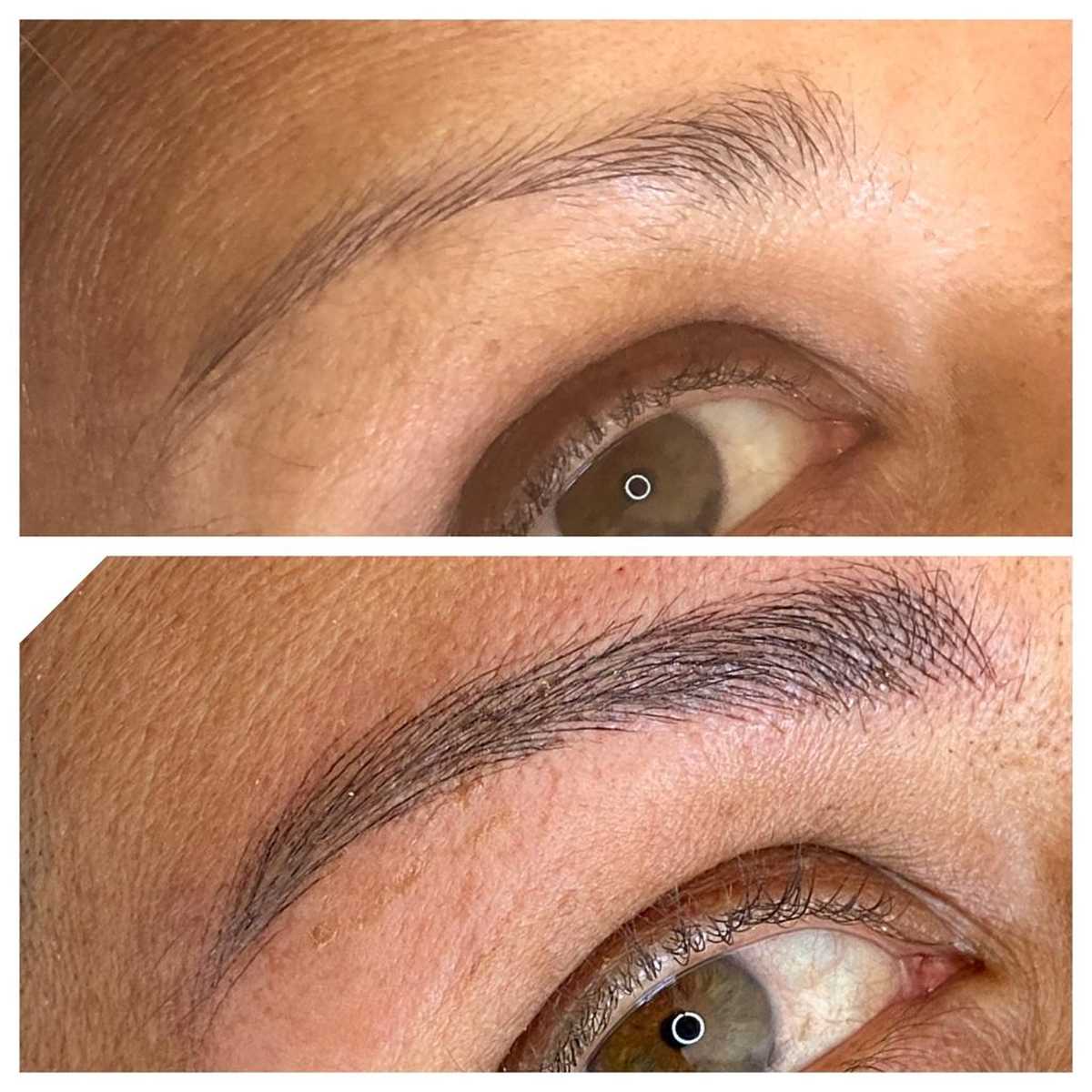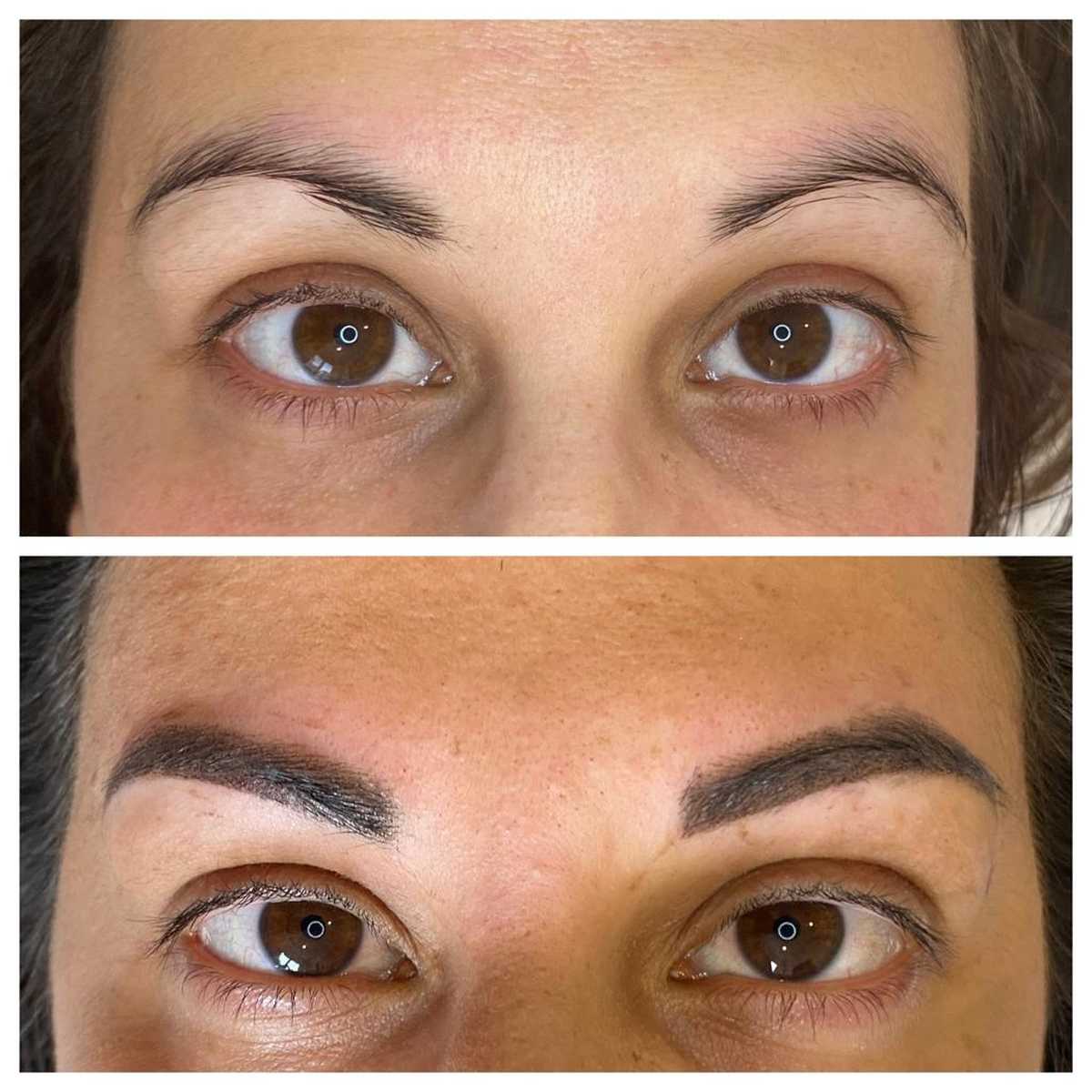Microblading, like tattoos, employs semi-permanent ink. Unfortunately, this resemblance contributes to the widespread misunderstandings that surround the method. Here, we dispel several common fallacies about microblading and outline the key differences between traditional eyebrow tattooing and microblading.
It's okay if you gave in to the tweezing fad of the '90s; many people did. Unfortunately, many of us now feel the effects of the terrible errors of our youth. Women are already seeking methods to restore their naturally thick brows.
For some, an eyebrow pencil is a canvas to create works of art. However, many women need assistance to achieve a brow that looks natural. The end product usually could be better at best. Microblading saves the day for people with thin eyebrows and time crunchers alike.
Microblading is a type of cosmetic tattooing that can make your eyebrows look thicker and fuller. It aids in attaining semi-permanent effects that provide the impression of thick, full brows. But first, let's dispel some of the rumours about microblading. Looking for microblading salon? Look no further,Cosmetic Tattoo by Rach got you covered.
Myths About Eyebrow Microblading (And Facts To Disprove Them!)
Microblading Is A Type Of Brow Tattoo.
Fact: Microblading is not the same thing as getting your eyebrows tattooed. Microblading, at first glance, appears to be similar to tattooing. Colour pigments are inserted into the skin using an instrument by trained professionals. However, that is the only area where the two methods overlap.
Ink is used in the process of tattooing. Microblading, on the other hand, uses a unique pigment to create deeper colour.
There are non-toxic organic pigments available for use in microblading. Tattoo inks have a reputation for containing harmful heavy metals. In addition, tattooing causes the ink to be deposited deeply into the dermis, where it will remain for the rest of the tattoo's life. Microblading doesn't go any deeper than the surface of the skin. As a result, the pigment will fade into a more natural colour without brown or green tints.
Avoid Getting Your Brows Wet For A Few Days Following The Surgery.
Fact: As soon as you come home, wash your eyebrows with lukewarm water and sensitive skin soap to get rid of any dried blood or lymph that may be oozing out of your cuts (gently, think fingertips, lukewarm water, softly, and sensitive skin soap). To allow the wounds to heal properly, they must be kept dry and clean.
The Results Of Microblading Are Permanent.
Fact: The effects of microblading last for around half a year. This misconception stems from misunderstandings about how microblading is performed. Microblading, unlike tattoos, places pigment more superficially on the skin. This implies that it will gradually diminish over time without looking artificial.
There is a 28-day cycle in our skin's renewal process. Within 28 days, dead skin cells are naturally shed, and new, healthy ones are generated. Microblading fades over time as your skin renews itself.
The results of microblading typically endure between 12 and 18 months. That will reduce the number of mornings you have to clean your face and draw on dimensionless eyebrows.
If You Have Oily Skin, It Is Preferable To Use The "Dry Healing" Method.
Fact: aftercare for the eyebrows should involve keeping the scabs wet even after the injuries have completely healed into dry crusts. Even oily skin requires aftercare: applying a tiny coating of aftercare balm to the microbladed area helps to regulate the amount of oil that seeps out of the pores.
Oily skin typically has trouble keeping colour because the oil from the porous structure pushes the pigment out. However, the skin is moisturised enough. In that case, it won't need to produce this extra oil, to begin with, kind of like fighting fire with fire, yeah, like that, trust me on this one; they have suffered from extremely oily skin and big pores all my life, and the only thing that controls my oily skin is adding oil-rich moisturisers! Just think about it!
Microblading Is Only Done Once.
Fact: About 4–6 weeks after the surgery, you'll want to go back for a touch-up.
Great microblading outcomes can be accomplished with a single treatment. Nonetheless, many women need one or more touch-ups. The colour will gradually fade over the course of four to six weeks.
Simple and painless, touch-up operations are a breeze. A professional will fill in any areas of fading with new pigment during a touch-up. Your eyebrows once touched up again, will appear as good as they did after the initial treatment.
A touch-up is technically the second phase of microblading, despite the name. Avoiding it could cause you to settle for less-than-ideal outcomes.
Frequently Asked Questions About Microblading
The removal of makeup is a painful process that frequently results in scarring. On top of being an expensive approach, this disadvantage adds insult to injury.
Additionally, allergic skin reactions are a possibility in most cases; this is one of the negative effects of microblading. Finally, the numbing cream and ink used are not suitable for all varieties of skin.
No. Even when it appears that your entire brow needs to be reshaped, it does not appear that semi-permanent brow procedures have any lasting effect on the way your natural hair grows. Although there are some factors to take into account, we will go into more detail about these factors in the following section.
However, even though widespread advertising promotes the immediate cosmetic results of microblading, the longer-term consequences and potential hazards of microblading should be discussed more frequently. Infections, allergic reactions, and unnaturally shaped brows are some of the potential side effects of brow shaping, none of which can be remedied immediately, if at all.
After five years, your once-black semi-permanent eyebrow tattoo is now a rusty orange or a steely blue. Nevertheless, your eyebrows look great, and the pigment did not spread outside the designated area throughout the shaping process. If your brows aren't overly dark, a microblading colour correction might help you improve their saturation.
The quick answer is that eyebrow microblading is well worth the cost. Getting your eyebrows microbladed is a safe and effective procedure, especially given the high skill and professionalism of today's semi-permanent makeup artists.
Pre-Numbing Changes The Texture Of The Skin And Reduces The Success Of Your Brow Microblading Treatment.
Fact: This is the worst urban legend of them all, yet even the best microblading artists worldwide swear by it. Our experience microblading over a thousand (and counting!) sets of eyebrows under anaesthesia disproves this, as do the opinions of every dermatologist we consulted. So, novices, before you begin your exquisite work, make your patient as relaxed and pain-free as possible by administering a numbing medication. You need not worry, future patient. The end of all suffering is in sight!
The Microblading Process Is Identical To Traditional Tattooing
Fact: Both Methods Have Their Unique Characteristics
Microblading is a non-traditional tattooing technique that has many distinct advantages:
- Different artists employ unique instruments throughout the process. For this procedure, a microblading artist will use a portable tool to implant the pigment. On the other hand, to inject the ink into your skin, the tattoo artist will utilise a tattoo machine gun.
- The inks that they employ also set them apart from one another. At the same time, conventional tattoo ink can be dangerous because, of its chemical components, the pigment used in microblading is all-natural and harmless.
- Microblading is performed differently since the artist implants the pigment into the skin's epidermis. This explains why the pigment disappears with time. However, a tattoo artist can inject the ink deeper into the skin, causing the colour to shift (to blue or green) and remain permanently.
Our exclusive range of eyebrow feathering services will help you in eyebrow microblading, feathering or hair stroke eyebrow tattooing procedures.
Overall, the microblading process is safer and the best therapy for beautiful eyebrows that last for a few years until the colour fades.
The Outcomes Of Microblading Will Not Appear Natural.
Fact: It's difficult to tell the difference between microblading and natural brows.
Microbladed eyebrows, in contrast to tattooed ones, are less noticeable and more subtle. This method allows the stylist to create the illusion of spontaneous hair growth. However, each stroke from the microblading instrument is a single, natural brown hair. Experts may be able to discern the difference, but the average individual has yet to hope of doing so.
Comparing it to a thin, pointy pencil is like using a fat crayon. A quality pencil will give you more realistic results than a crayon. Microblading is a semi-permanent technique that mimics the look of a natural eyebrow pencil. Microblading creates a more natural appearance than filling your brows with a pencil.
Professionals Cannot remove Microblading Pigment.
Fact: Microblading can be safely removed by a trained professional.
If you get microblading and don't like the results, you don't have to live with them forever. A trained practitioner can safely remove Microblading pigment.
Always seek the advice of a trained expert before attempting to remove microblading on your own. It will not disappear with a quick wash. If you want to avoid skin harm during the removal process, you should have a professional do it.
The Procedure Is Available To Everyone
Fact: Not everyone can benefit from microblading.
It would be best if you were over 18 to get an eyebrow makeover. A person may be unable to undergo the microblading process due to various personal or medical factors.
If any of the following apply to you, postpone the procedure:
- Since you have health concerns, you must talk to your doctor before scheduling an appointment.
- That's because you're a breastfeeding mother.
- You are pregnant.
- Because of blood-thinning medications, you are on medication.
- You have altered your appearance with facial treatments like microdermabrasion, Botox, or fillers.
It's only natural that individuals would have many concerns regarding the microblading process; nonetheless, certain common misconceptions about the operation must be dispelled. Unfortunately, as microblading grows in popularity, so does the number of false beliefs about it.
Microblading Is A Painful Procedure.
Fact: The microblading procedure might be painful.
If you're worried about how painful microblading might be, you shouldn't let that stop you. Microblading is a lot less uncomfortable than getting a tattoo. However, when it comes to discomfort, they are poles apart.
Certified microblade artists have extensive education, training, and experience in the field. But unfortunately, they also resort to painkillers like numbing cream. A lot of ladies compare the agony to that of tweezing.
Tenderness in the area is common the day following surgery. To those with fair skin, this could feel like a sunburn. Some of the others may exhibit symptoms of minor bruises. Both are common reactions to the gentle pressure of drawing near the eye, and they should go away within a few days.
Healing and final pigmentation of the skin may take up to four weeks. Your skin's sensitivity may increase throughout this time, but it won't hurt.
I Can Acquire The Same Brows As My Friend If I Go To The Same Medical Spa.
Fact: Every person will have a unique experience with microblading.
All individuals have their special qualities. Indeed, everyone's skin is different, and their eyebrows are too. There are a few things to consider before beginning treatment. That includes, but is not limited to:
- Your eyebrows' original contour and shape.
- Characteristics of the Skin
- Rate of skin renewal or cell turnover
- The shade of pigment you pick will
- Parametric symmetry of the face
The first step is to consult with a technician via an introductory consultation. Understanding what to expect before and after the surgery is important. It's a good chance to discuss your skin woes and have them all sorted out.
Microblading Can Be Done At Home Or In A Nearby Hair Salon.
Fact: Finding a reliable source is essential for getting desirable outcomes while minimising the likelihood of undesirable side effects.
Microblading is a form of tattooing that is less intrusive than traditional but still requires puncturing the skin. Similarly, to tattooing, infection is a major concern throughout the operation. Therefore, it would be best if you made an effort to choose a place that meets your standards for cleanliness and safety.
Similar to hair or tattoo parlours, certain establishments may have more modern facilities and use more experienced professionals. For example, health officials have visited and given Vibrance Medspa the green light to perform microblading and permanent cosmetics services.
Microblading, a form of tattooing, is done for cosmetic reasons. An expert microblading artist is essential for getting the best results. You might only like how your brows turn out if you do this.
Microblading Will Leave Scars
Fact: Plastic surgeons have the training to undertake this treatment, and the results will be undetectable afterwards. Microblading is a form of tattooing, so you'll need to take the same precautions with aftercare to ensure that your brows recover properly. An expert at a medical spa will provide you with personalised advice on maintaining your brows. Want to know more about our eyebrow tattoo services?
Conclusion
Microblading cosmetic tattooing can create bigger, thicker eyebrows. It employs a different pigment to achieve a darker colour and doesn't reach deeper than the skin, like eyebrow tattoos. A gentle wash with lukewarm water and sensitive skin soap might remove crusted blood or lymph from eyebrow cuts. Your skin will shed old cells and create new, healthy ones during the 28-day microblading process. Microblading lasts 12–18 months.
After eyebrow threading, keeping the scabs moist and adding a small coating of aftercare balm will reduce oil release from pores. Four to six weeks following surgery, the colour usually fades. Professional pigmentation can fix any fading. However, ignoring it may have negative consequences. Microblading is a semi-permanent eyebrow pencil that a professional may safely remove.
It is the best and safest way to get beautiful eyebrows that last for years before fading. Microblading strokes seem like natural brown hair, making them hard to distinguish. Microblading isn't for everyone; you must be 18 to modify your eyebrows.
Microblading hurts less than tattoos. Despite their extensive expertise and experience, professional micro bladers use numbing cream to help their clients. After surgery, the skin may be sensitive and take up to four weeks to heal and pigment. Therefore, before microblading, patients should consider their needs. Microblading punctures the skin, however, less than tattooing.
This cosmetic surgery requires a trained microblading artist. Choosing a clean, secure place is important due to the potential for illness. Plastic surgeons can do this treatment with undetectable results. A medical spa practitioner can advise you on brow care.
Content Summary
- Microblading, like tattoos, employs semi-permanent ink.
- Unfortunately, this resemblance contributes to the widespread misunderstandings that surround the method.
- Microblading is a type of cosmetic tattooing that can make your eyebrows look thicker and fuller.
- It aids in attaining semi-permanent effects that provide the impression of thick, full brows.
- Microblading is not the same thing as getting your eyebrows tattooed.
- Microblading, at first glance, appears to be similar to tattooing.
- Microblading, on the other hand, uses a unique pigment to create deeper colour.
- There is a 28-day cycle in our skin's renewal process.
- Microblading fades over time as your skin renews itself.
- About 4–6 weeks after the surgery, you'll want to go back for a touch-up.
- Nonetheless, many women need one or more touch-ups.
- The colour will gradually fade over the course of four to six weeks.
- Simple and painless, touch-up operations are a breeze.
- A professional will fill in any areas of fading with new pigment during a touch-up.
- A touch-up is technically the second phase of microblading, despite the name.
- For this procedure, a microblading artist will use a portable tool to implant the pigment.
- On the other hand, to inject the ink into your skin, the tattoo artist will utilise a tattoo machine gun.
- However, a tattoo artist can inject the ink deeper into the skin, causing the colour to shift (to blue or green) and remain permanently.
- Overall, the microblading process is safer and the best therapy for beautiful eyebrows that last for a few years until the colour fades.
- Microblading is a semi-permanent technique that mimics the look of a natural eyebrow pencil.
- Microblading creates a more natural appearance than filling your brows with a pencil.
- Microblading can be safely removed by a trained professional.
- A trained practitioner can safely remove Microblading pigment.
- Always seek the advice of a trained expert before attempting to remove microblading on your own.
- Since you have health concerns, you must talk to your doctor before scheduling an appointment.
- Naturally, individuals have many concerns regarding the microblading process; nonetheless, certain common misconceptions about the operation must be dispelled.
- If you're worried about how painful microblading might be, you shouldn't let that stop you.
- Tenderness in the area is common the day following surgery.
- Healing and final pigmentation of the skin may take up to four weeks.
- Every person will have a unique experience with microblading.
- There are a few things to consider before beginning treatment.
- Characteristics of the Skin Rate of skin renewal or cell turnover the shade of pigment you pick will have Parametric symmetry of the face first step is to consult with a technician via an introductory consultation.
- Understanding what to expect before and after the surgery is important.
- It's a good chance to discuss your skin woes and have them all sorted out.
- Microblading, a form of tattooing, is done for cosmetic reasons.
- An expert microblading artist is essential for getting the best results.
- Microblading is a form of tattooing, so you'll need to take the same precautions with aftercare to ensure that your brows recover properly.
- An expert at a medical spa will provide you with personalised advice on maintaining your brows.



